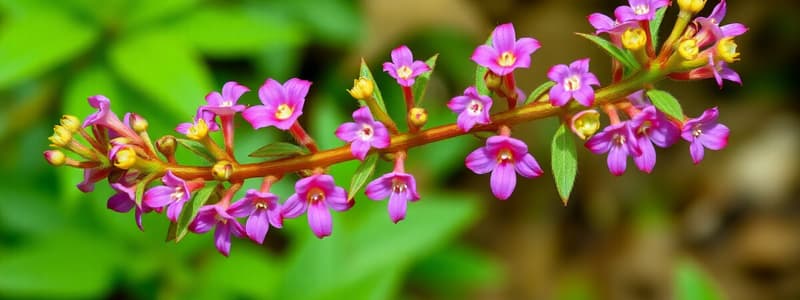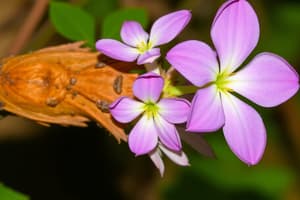Podcast
Questions and Answers
What is the primary pharmacological activity of Fagaronine?
What is the primary pharmacological activity of Fagaronine?
- Antimicrobial activity
- Antioxidant activity
- Anti-sickling activity
- Antimalarial activity (correct)
Which of the following acids from Fagara root is associated with anti-sickling activity?
Which of the following acids from Fagara root is associated with anti-sickling activity?
- Amino acid
- Ascorbic acid
- Vanillic acid (correct)
- Salicylic acid
In terms of macroscopic features, what characteristic color does Fagara root exhibit?
In terms of macroscopic features, what characteristic color does Fagara root exhibit?
- Yellow (correct)
- Brown
- White
- Red
Which species is NOT mentioned as an allied drug to Rauwolfia?
Which species is NOT mentioned as an allied drug to Rauwolfia?
What is the traditional use of Fagara root?
What is the traditional use of Fagara root?
What is the main purpose of leaving some Rauwolfia roots in the ground during collection?
What is the main purpose of leaving some Rauwolfia roots in the ground during collection?
Which characteristic distinguishes the xylem of Rauwolfia from that of Rauwolfia vomitoria?
Which characteristic distinguishes the xylem of Rauwolfia from that of Rauwolfia vomitoria?
What is the approximate size range of Rauwolfia roots?
What is the approximate size range of Rauwolfia roots?
Which of the following statements about the chemical constituents of Rauwolfia is correct?
Which of the following statements about the chemical constituents of Rauwolfia is correct?
What is a significant reason for encouraging the cultivation of Rauwolfia?
What is a significant reason for encouraging the cultivation of Rauwolfia?
What distinguishes the structure of the cork in Rauwolfia roots?
What distinguishes the structure of the cork in Rauwolfia roots?
Which alkaloid from Rauwolfia is associated with treating mental disorders?
Which alkaloid from Rauwolfia is associated with treating mental disorders?
What is the growth pattern of the bark of older Rauwolfia roots?
What is the growth pattern of the bark of older Rauwolfia roots?
Flashcards
Fagara root
Fagara root
A small tree, typically 6-12 meters high, with numerous hooked thorns. The dried root of this tree is known as Fagara root and is used in traditional medicine.
Fagaronine
Fagaronine
An antimalarial alkaloid found in Fagara root, derived from the Zanthoxylum species.
Berberine
Berberine
A type of alkaloid known for its antimicrobial properties, commonly found in Fagara root.
Chelerythrine
Chelerythrine
Signup and view all the flashcards
Para-hydroxy benzoic acid
Para-hydroxy benzoic acid
Signup and view all the flashcards
What is Rauwolfia?
What is Rauwolfia?
Signup and view all the flashcards
How is Rauwolfia collected and prepared?
How is Rauwolfia collected and prepared?
Signup and view all the flashcards
Describe the macroscopy of Rauwolfia.
Describe the macroscopy of Rauwolfia.
Signup and view all the flashcards
Describe the microscopic features of Rauwolfia root.
Describe the microscopic features of Rauwolfia root.
Signup and view all the flashcards
What are the chemical constituents of Rauwolfia?
What are the chemical constituents of Rauwolfia?
Signup and view all the flashcards
What are some of the important Rauwolfia alkaloids and their uses?
What are some of the important Rauwolfia alkaloids and their uses?
Signup and view all the flashcards
What are the main uses of Rauwolfia?
What are the main uses of Rauwolfia?
Signup and view all the flashcards
Why is the cultivation of Rauwolfia encouraged?
Why is the cultivation of Rauwolfia encouraged?
Signup and view all the flashcards
Study Notes
Rauwolfia: Botanical Definition
- Rauwolfia consists of dried rhizome and roots of Rauwolfia serpentina L. Benth. ex Kurz (Apocynaceae).
- It's a small shrub found in India, Pakistan, Burma, Thailand, and Java.
Rauwolfia: Collection and Preparation
- Collected mainly from wild plants.
- Some roots must be left in the ground to allow regeneration.
- After collection, the drug is cut transversely and dried.
- Cultivation via nodal and cell culture is encouraged due to:
- Depletion of wild plants.
- Destructive nature of root collection.
- Low seed viability.
- Endangered species status.
Rauwolfia: Macroscopy
- Roots are rarely branched.
- Bark of older roots readily falls off, exposing wood.
- Longitudinal wrinkles/ridges found on young and old pieces.
- Rhizomes differ from roots, having a small central pith and occasional attached aerial stems.
- Shape: cylindrical or slightly tapering, tortuous pieces.
- Size: 2-10 cm long, 5-22 mm in diameter.
- Colour: greyish yellow or brown.
- Fracture: short.
- Odour: slight, decreases with age.
- Taste: bitter.
Rauwolfia: Microscopy
- Cork is divided into 2-8 zones with smaller suberized/unlignified cells alternating with larger lignified cells.
- Secondary cortex is parenchymatous with starch.
- Phloem is parenchymatous with sieve tubes and calcium oxalate crystals/prisms.
- Sclerenchyma is absent in the phloem (distinguishes it from other species, e.g., R. vomitoria).
- Xylem is totally lignified, with 3-6 growth rings.
- Medullary rays contain starch and alternate with rays of secondary xylem.
- Secondary xylem consists of vessels, fibres, and parenchyma.
- Vessels are ≤ 57 µm in diameter (distinguishing it from other species, e.g., R. vomitoria vessels ≤ 180 µm).
Rauwolfia: Chemical Constituents/Uses
- Rauwolfia contains 0.7-2.4% alkaloids, consisting of at least 40 different alkaloids.
- Geographical source affects alkaloid content (India and Pakistan are preferred).
- Important alkaloids and their uses include:
- Reserpine: hypertension and mental disorders.
- Rescinnamine: hypertension.
- Ajmaline: cardiac arrhythmias.
- Ajmalicine: blood circulatory diseases.
Rauwolfia: Allied Drugs
- 86 Rauwolfia species identified, many used to adulterate R. serpentina.
- Allied drugs include R. vomitoria and R. tetraphylla.
Fagara Root: Botanical Definition
- Fagara root is the dried root of Zanthoxylum zanthoxyloides Waterman and other Zanthoxylum species (Rutaceae).
- Synonym: Fagara zanthoxyloides Lam.
- Yoruba name: Orin ata / Igi ata.
- A small tree (6-12 m high) with many hooked thorns (about 12 mm in length) at the stem base.
Fagara Root: Macroscopy and Microscopy
- Shape: cylindrical and tortuous with attached rootlets.
- Colour: yellow.
- Taste: peppery and tingling.
- Cork layer has alternate layers of lignified and unlignified cells.
- Pericylic fibres are present but less abundant; vessels are numerous.
Fagara Root: Active Chemical Constituents/Pharmacological Activities
- Major alkaloids:
- Fagaronine (antimalarial activity).
- Berberine (antimicrobial activity).
- Chelerythrine (antimicrobial activity).
- Major acids:
- Para-hydroxy benzoic acid (anti-sickling activity).
- 2-hydroxymethylbenzoic acid (anti-sickling activity).
- Vanillic acid (anti-sickling activity).
- Traditional use: chewing stick for teeth brushing.
Studying That Suits You
Use AI to generate personalized quizzes and flashcards to suit your learning preferences.


